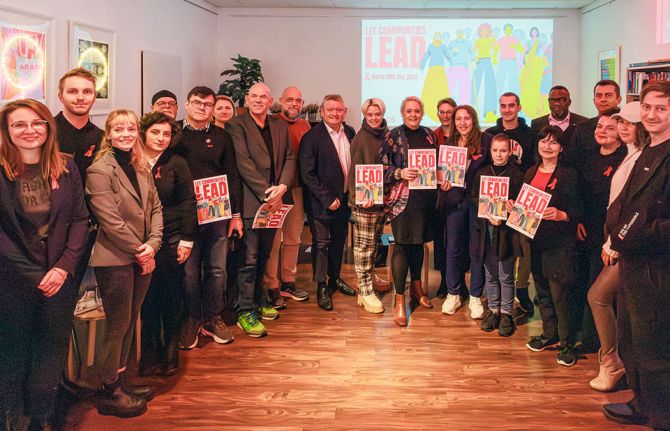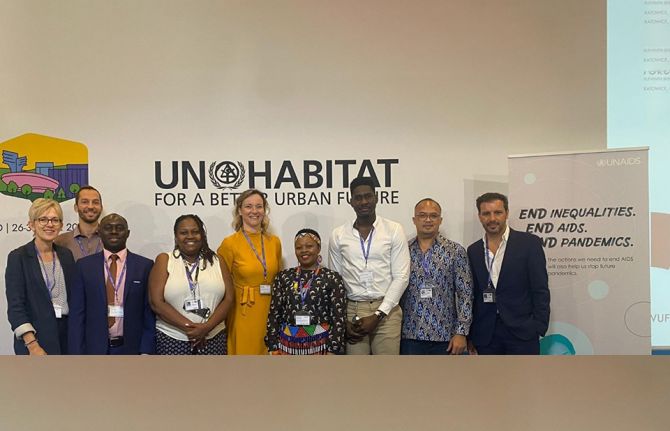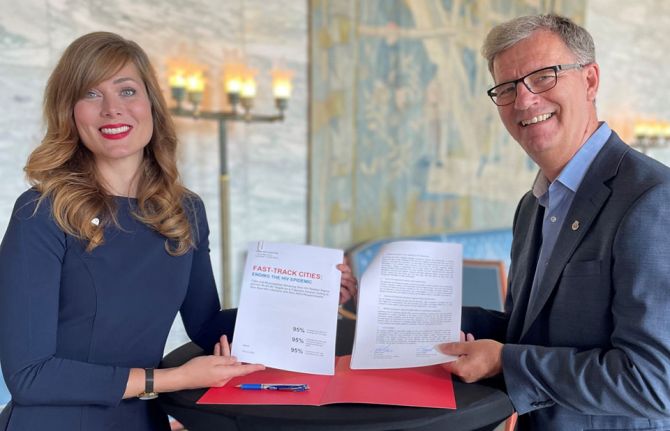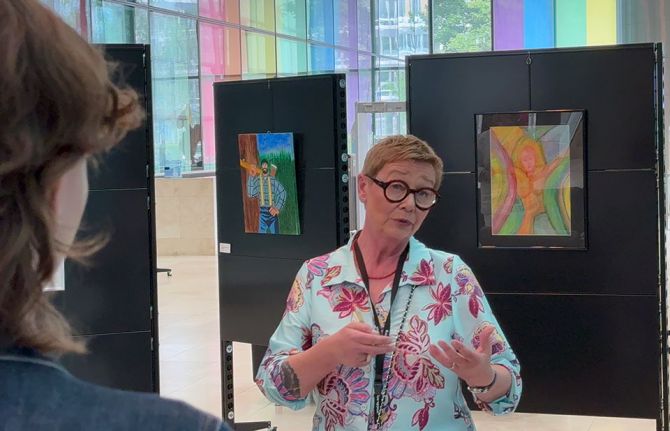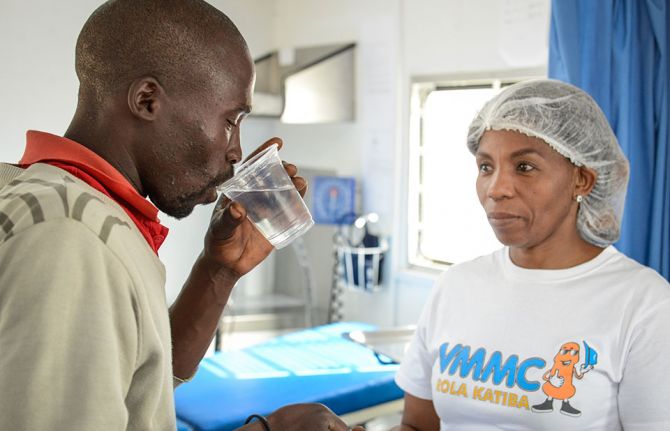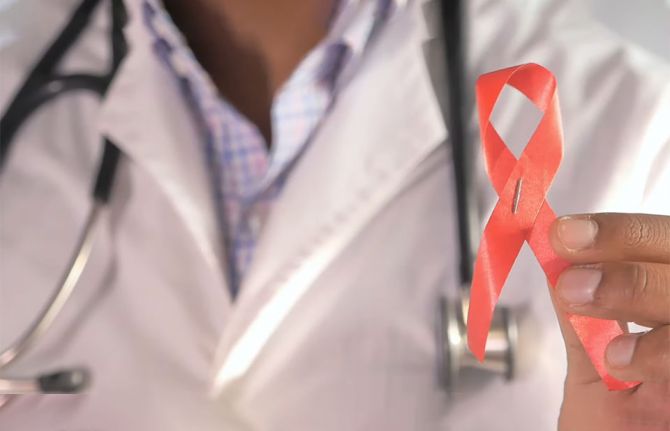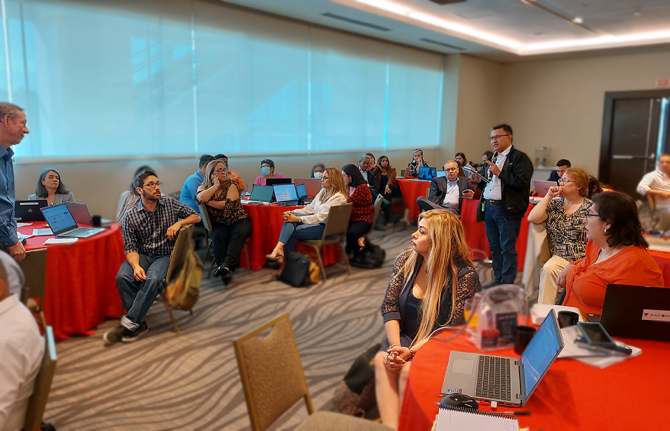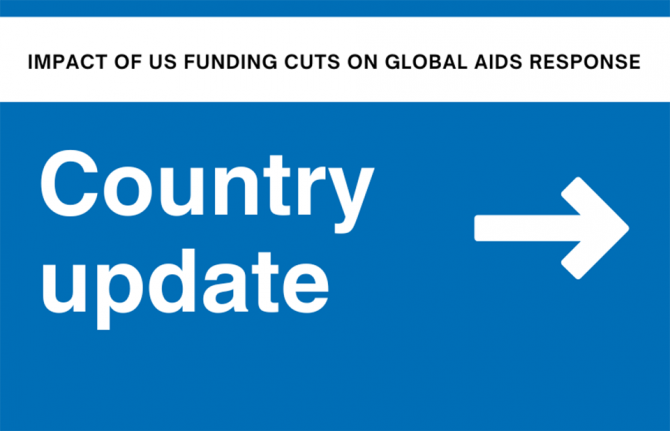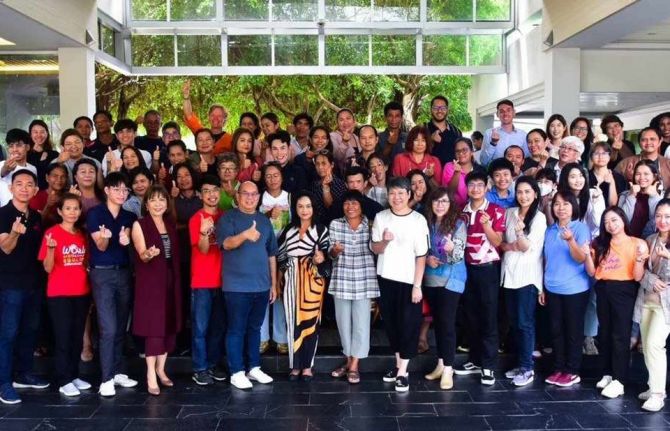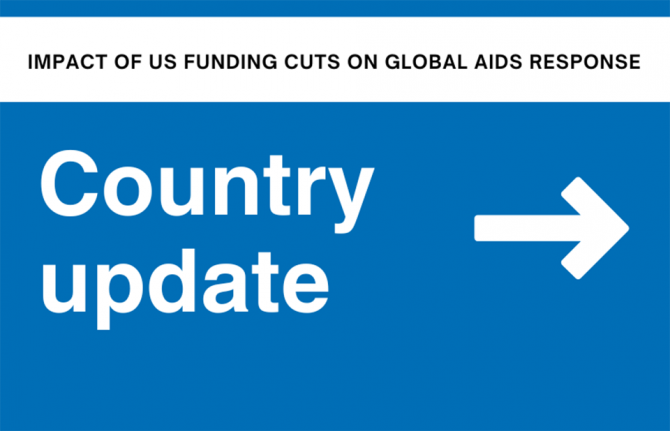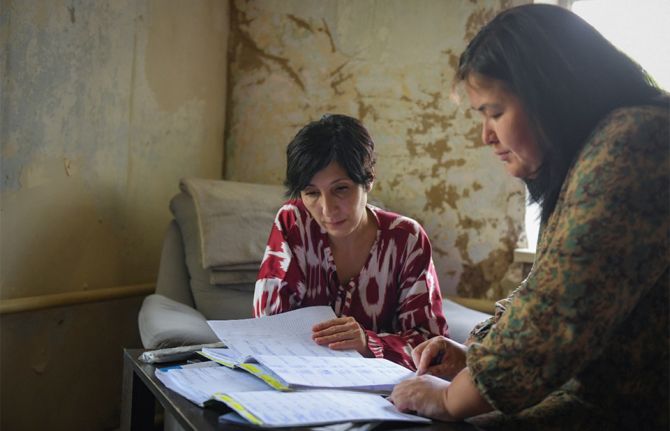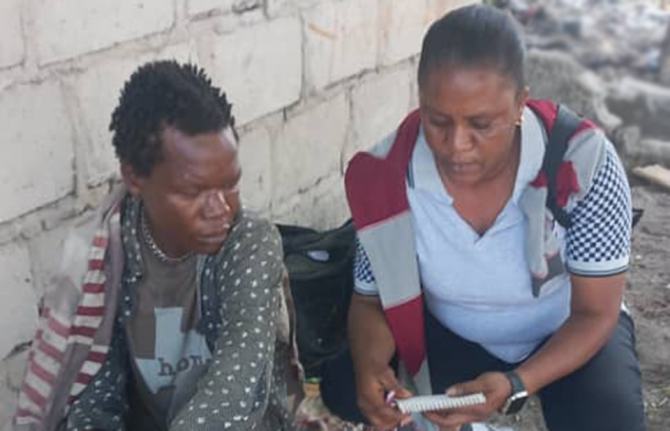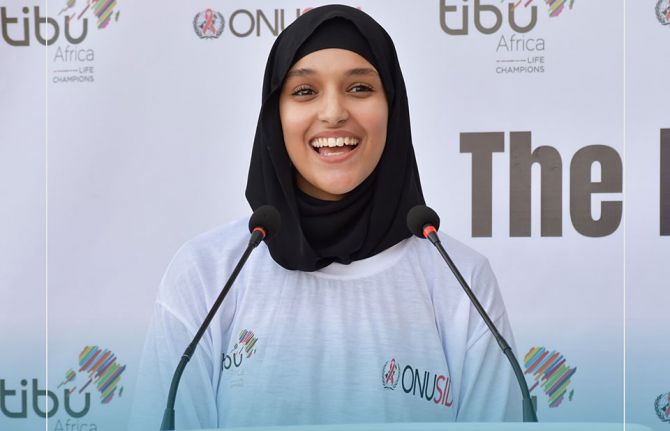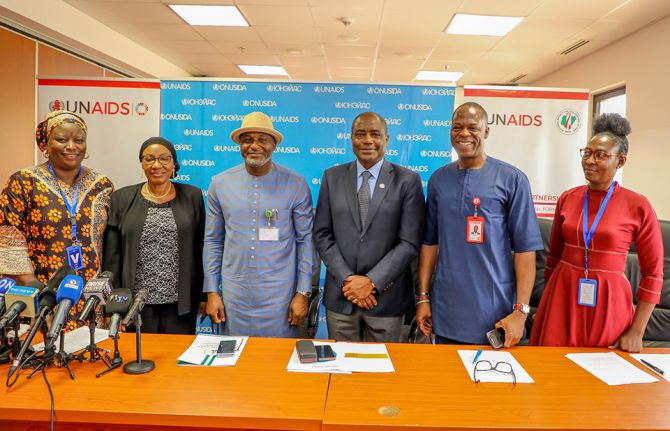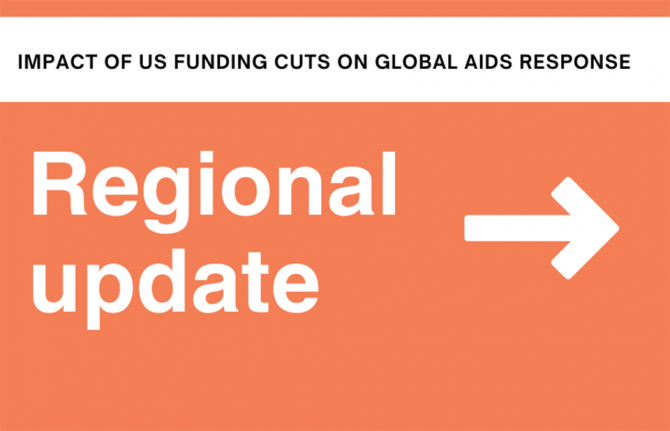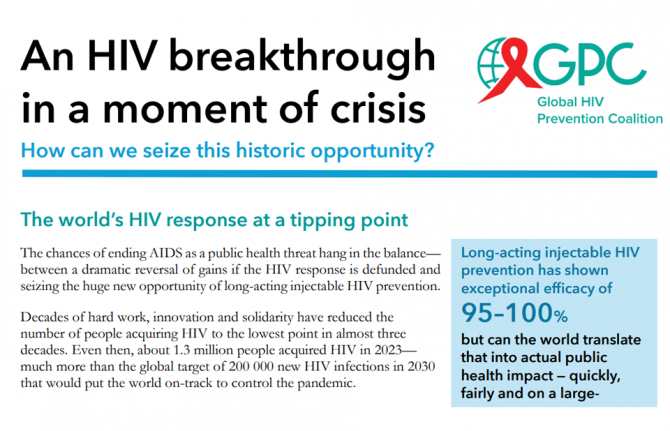
Feature Story
2006 AIDS epidemic update launch
23 November 2006
23 November 2006 23 November 20062006 AIDS epidemic update launch in Germany:
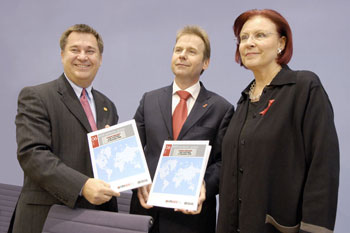
Mrs. Heidemarie Wiezcorek - Zeul, Minister for Economic Cooperation and Development of Germany, Mr. Bertil Lindblad representing UNAIDS and Dr. Ulrich Heide, Executive Director of Deutsche AIDS Stiftung during the launch of the 2006 AIDS epidemic update.
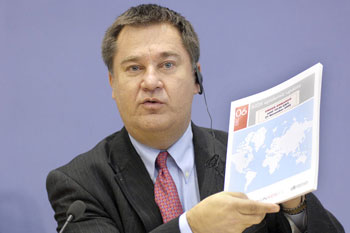
Mr. Bertil Lindblad presenting the report.
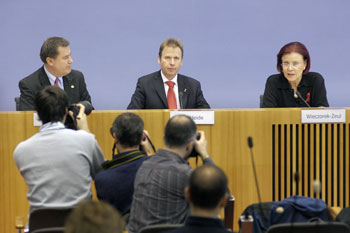
Mrs. Heidemarie Wiezcorek - Zeul, Minister for Economic Cooperation and Development of Germany, Mr. Bertil Lindblad representing UNAIDS and Dr. Ulrich Heide, Executive Director of Deutsche AIDS Stiftung addressing the press during the launch.
2006 AIDS epidemic update launch in Denmark:
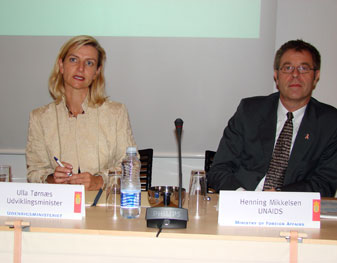
Mrs. Ulla Tørnæs , Minister for Development Cooperation of Denmark and Mr. Henning Mikkelsen representing UNAIDS.
Photo credit for Germany: T. Leukert
Photo credit for Denmark: AIDS-Fondet

Feature Story
Inauguration of the new UNAIDS/WHO building
21 November 2006
21 November 2006 21 November 2006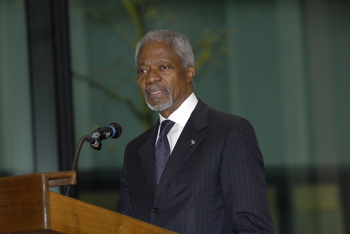
Mr. Kofi Annan, United Nations Secretary General

Dr. Peter Piot, Executive Director, UNAIDS

H.E. Ms. Gunilla Carlsson, Swedish Minister for International Development Cooperation
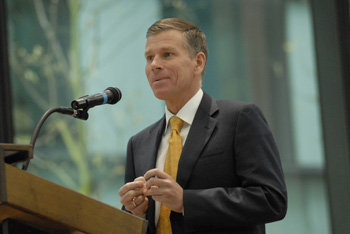
Dr. Anders Nordström, Acting Director-General, WHO
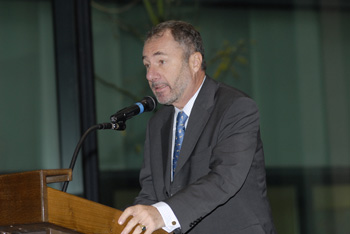
H.E. Mr. Blaise Godet, Ambassador, Permanent Representative of Switzerland to the United Nations Office and other International Organizations in Geneva.

Mr. Mark Muller, Conseiller d'Etat du Département des constructions et des technologies de l'information, Conseil d'Etat de la République et Canton de Genève.
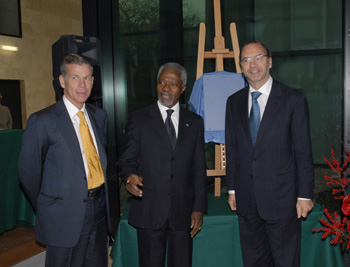
United Nations Secretary-General, Mr. Kofi Annan, Executive Director of UNAIDS, Dr. Peter Piot and Acting Director-General of WHO, Dr. Anders Nordström, during the display of the building inauguration plaque.
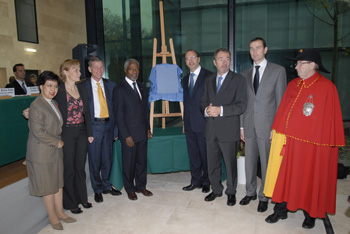
Oficial display of the building inauguration plaque.

United Nations Secretary-General, Mr. Kofi Annan, Executive Director of UNAIDS, Dr. Peter Piot and Acting Director-General of WHO, Dr. Anders Nordström, visiting the new building.
All photo credit : O. O'Hanlon

Feature Story
UNAIDS/WHO launch 2006 AIDS epidemic update
21 November 2006
21 November 2006 21 November 2006UNAIDS launched the new joint UNAIDS/WHO report, AIDS Epidemic Update 2006, featuring updated global and regional AIDS estimates and new trends in the epidemic’s evolution on 21 November 2006.
Key findings of the report will be presented, including:
- New evidence showing drop in HIV infection rates in several countries and among young people.
- However, global AIDS epidemic continues to grow, with some evidence of resurging epidemics.
- New data suggests where HIV prevention programmes have not been sustained and/or adapted as epidemics have changed
- infection rates in some countries are staying the same or going back up.
- HIV prevention and treatment programmes need to be sustained, adapted and focused to reach those most at risk.
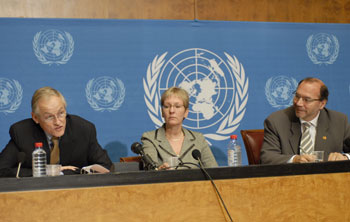 |
Executive Director of UNAIDS, Dr. Peter Piot, Ms. Karen Stanecki, UNAIDS Senior Epidemiologist and Dr. Kevin De Cock, Director of the department of HIV/AIDS at WHO during the launch of the 2006 AIDS epidemic update. |
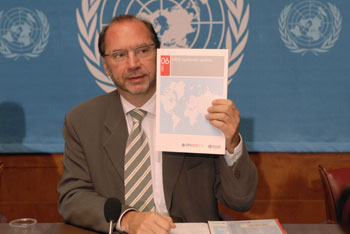 |
Executive Director of UNAIDS Dr. Peter Piot presenting the report. |
 |
UNAIDS Senior Epidemiologist, Ms. Karen Stanecki addressing the press |
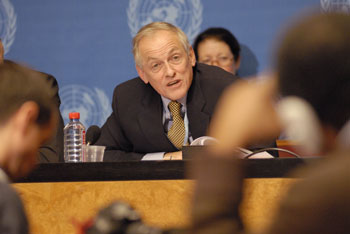 |
Dr. Kevin De Cock, Director of the department of HIV/AIDS at WHO during the press conference. |
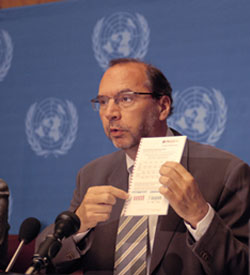 |
Executive Director of UNAIDS Dr. Peter Piot illustrating some of the information contained in the update. |
View photo gallery of the 2006 epidemic update launch in Germany and Denmark
All photo credit : O. O'Hanlon

Feature Story
Secretary General visits UNAIDS, Geneva
20 November 2006
20 November 2006 20 November 2006
Photo credit : UNAIDS\O. O'Hanlon
The United Nations Secretary General Kofi Annan urged the international community to continue to “fight to bring the global AIDS epidemic under control” as he visited UNAIDS in Geneva on Monday 20 November.
“In a short quarter of a century, AIDS has drastically changed our world. At least 25 million people have died of it; almost 40 million live with HIV today. AIDS, tuberculosis and malaria make up the deadliest triad the world has known,” he said, on his final visit to the UNAIDS Secretariat in his capacity as United Nations Secretary General.
“But at the same time, there is more than ever reason for hope. We can see how much things have changed, how the world is joining forces,” he added.
During his term in office Kofi Annan has been a pioneer in the AIDS response calling it ‘a personal priority’. “Even as I leave the office of the Secretary General, I assure you I will continue to fight AIDS,” he said, as he officially inaugurated the new UNAIDS/WHO building which will house both the UNAIDS Secretariat and the HIV, TB and malaria departments from WHO.
UNAIDS Executive Director Peter Piot underlined the importance of the Secretary General’s contribution and commitment to the AIDS response. “ If the world is now increasing acting against AIDS it is in no small part because of the leadership of Secretary General Kofi Annan,” he said “I trust you will remain an AIDS activist as I know your commitment is a passion way beyond your duty as Secretary General,” he added.
During his visit to the new UNAIDS/WHO building – designed by Baumschlager and Eberle architechts – the Secretary General also met with several artists who’s work on and around AIDS is displayed around the new building. He then visited the UNAIDS conference room which is named after him in recognition of his exceptional contribution to the AIDS response.
“This house will not only bring UNAIDS and WHO closer together. It will also be a meeting place for ideas, a centre for dialogue, a forum bringing together people and organizations, in the UN and beyond, to strengthen the global response against AIDS, TB and malaria. In this way, the building will be a nerve centre in our mission to reach the Millennium Development Goals and build better lives for people in the 21 st century,” he said.
Also speaking at the opening of the UNAIDS/WHO building were H.E.Ms Gunilla Carlsson, Swedish Minister for International Development Cooperation and Chair of the UNAIDS Programme Coordinating Board; Dr Anders Nordström, Acting Director General of the World Health Organization, H.E Mr Blaise Godet, Ambassador, Permanent Representative of Switzerland to the United Nations Office and other International Organizations in Geneva and Mr Mark Muller, State Councillor of Geneva (Conseiller d’Etat chargé du Département des constructions et des technologies d’information, Conseil d’Etat de la République et Canton de Genève).
Read:
Speech by UNAIDS Executive Director, Dr. Peter Piot (PDF, 30 Kb)
Speech by WHO Acting Director-General, Dr. Anders Nordström (PDF, 30 Kb)
Allocution by Ambassador Blaise Godet , Mission of Switzerland to the UNOG and other I.O. (PDF, 256 Kb), on the occasion of the UNAIDS HQ inauguration ceremony in Geneva on November 20, 2006

Feature Story
Buddhist Monks raise AIDS awareness in Laos
14 November 2006
14 November 2006 14 November 2006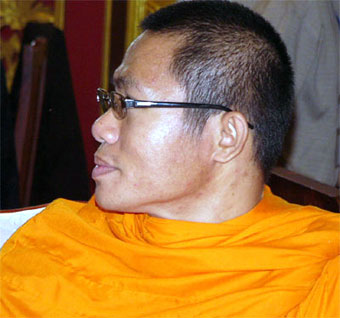
Every morning Buddhist Monk Maytryjit gets up at 3:45 am to meditate for one hour. Afterwards, he walks through the streets of Vientiane in the Lao Peoples Democratic Republic to collect his food alms.
However, this October he took time out of his usual routine to catch a flight to Pakse to attend a workshop convened by UNAIDS Cosponsor the United Nations Development Programme (UNDP) entitled Leadership for Results, which brought together more than 100 representatives from several provinces including Buddhist monks, government ministries and people living with HIV.
UNDP’s Leadership for Results training workshops aim to develop the capacity of local leaders to transform the response to AIDS by promoting leadership at all levels. A series of workshops were held, the final one in Pakse where the leaders attending formed seven “break through” groups in charge of developing proposals for a transformed response to AIDS in the country. The “break through” initiatives focused on increasing HIV prevention among women living in rural settings, improving access to condoms within the Army and increasing access to information on HIV through radio.
Ms. Setsuko Yamazaki, UNDP Resident Representative, a.i. said, “The rationale behind the Leadership for Results programme is to encourage the formation of strong leadership on AIDS related issues within all sectors, beyond those traditionally involved in the epidemic’s response.”
“This involves stimulating a deep-rooted shift within individuals, organizations and communities, to enable them to see AIDS from a new perspective, identify new possibilities and take action,” she added.
As a follow up to the workshop, the group committed to carrying out ten HIV prevention pilot projects at bus stations, markets and villages, with the aim of reaching out to thousands of people. Using radio programmes and loudspeakers, Monk Maytryjit and his group will also begin disseminating AIDS information during religious ceremonies, including one of Laos’ most significant religious festivals, the Pha That Luang (The Great Stupa or Sacred Reliquary) that is held in November.
“According to Buddhist philosophy one needs to follow the right path and an important part of our life-skills is to treat every person equally. It is important therefore to reduce stigma against people living with HIV in Laos and to help their families,” said Monk Mayrtyjit.
For more information: Ms. Yasmin Padamsee Forbes or Ms. Soukphaphone Thongsavanh
+ (856 21) 213390-5 ext. 187 or 210, yasmin.forbes@undp.org , soukphaphone.thongsavanh@undp.org
This story first appeared on the UNDP Lao web site www.undplao.org
All photo credit : Yasmin Padamsee/UNDP

Feature Story
Increased HIV services for drug users needed
14 November 2006
14 November 2006 14 November 2006Increasing access to HIV prevention, treatment, care and support services for drug users and their partners is crucial to addressing the issue of growing HIV infections related to injecting drug use in the Middle East and North Africa region.
This was the overwhelming conclusion reached by regional representatives from law enforcement agencies, national AIDS programmes, NGOs, researchers, community representatives, people living with HIV and UN organizations who joined at a regional workshop on the issue of HIV and drug use in the region, held in Cairo, Egypt from 5 – 8 November.
Throughout the 3-day discussions, participants from the Arab countries, Afghanistan, Iran and Pakistan affirmed that drug use is an important risk factor in facilitating spread of HIV that calls for immediate action. Joint efforts of police, national AIDS actors, NGOs, drug users and of people living with HIV were recognized as fundamental elements in the prevention of HIV among drug users and their partners.
While significant efforts are being undertaken in a number of countries to reach out with HIV preventive services to drug users communities, limited capacities coupled with discrimination against drug users hamper implementation of wider-scale programmes.
“From my personal experience and my field work on reducing harm related to drug use, I suggest training more drug users and ex-drug users –to build their skills in order to promote and implement [HIV preventive] programs in the region,” an ex-drug user and outreach worker said in the workshop.
New initiatives for building capacities of civil society actors on implementing harm reduction measures and networking in the region were discussed and examined.
“Participation in this workshop has allowed an exchange of international experiences among NGOs and governments, and a discussion of the strategic approaches to planning at the national level to protect against the harms and risks of drugs and related HIV. It has created cooperation between [national stakeholders]…and encouraged civil society actors to assist and support alternative programs for drug users,” police participants from one of the Gulf countries said.
As part of the workshop, UNAIDS and UNODC launched the finalized Rapid Situation Assessment on Drug Use and HIV in Algeria and Morocco, as well as facilitate consensus on programmatic follow up for all participating countries. WHO and the International Harm Reduction Association launched a project on strengthening the role of civil society in harm reduction for injecting drug users in the Middle East and North Africa.
Although the main mode of HIV transmission in the Middle East and North Africa remains unprotected sexual contact, injecting drug use is an increasingly important factor in the region’s epidemics.
Related

Feature Story
Towards universal access: West and Central Africa
07 November 2006
07 November 2006 07 November 2006"Towards Universal Access to Prevention, Treatment, Care and Support in the West and Central African Region”
The renewed commitment to universal access to prevention, treatment, care and support undertaken by countries across the world, has paved the way in West and Central Africa to more inclusive dialogue among partners, galvanizing consensus around the core challenges currently obstructing the national response, and strengthening joint determination to scale up national programmes.
The process of scaling up towards universal access in West and Central Africa has demonstrated the positive impact that broad and collaborative partnerships can provide, bringing together actors from government, civil society, (including people living with HIV, faith-based organizations, women’s groups, networks of health NGOs, youth associations, community based organizations), the media, the private sector, and bilateral and multilateral partners. This broad partnership set the backdrop for informed and open discussion on central themes of the national consultations, for example, raising issues around the importance of prevention as a means to ensure the sustainability of treatment provision.
The UNAIDS Regional Support Team in Dakar has extensively supported the meaningful involvement of civil society which has been of varying but increasing frequency/intensity, In several countries such as Burkina Faso, Mali, Nigeria and Senegal, civil society has been actively involved in both the target setting and review processes of national strategic planning, ensuring the critical input of West African civil society into regional and global fora. This participation was ensured at the Brazzaville regional consultation and the Abuja Heads of State Summit, but more significantly, enabled African civil society to contribute to “ Africa’s Common Position to the UN General Assembly Special Session on HIV/AIDS” June 2006.
Significant momentum has built up on target setting and its follow up, facilitated by technical and financial support provided by the UNAIDS country and regional offices, the UN Country Team and UN Theme Group . Seventeen of the twenty countries who have held national consultations to date have set targets towards scaling up, with countries raising the bar of aspiration by setting far more ambitious goals for 2010, in line with the 2001 Abuja Declaration and the UN High Level Meeting of June 2006.
Progress made in West and Central Africa testifies to the central importance and utility of a strong strategic plan as the vehicle for reaching ambitious targets. Thirteen countries in all have developed nationally agreed roadmaps for scale-up over the next five years (2006-2010). Evidence suggests that those countries able to harmonize target setting with the strategic planning cycle, encountered far less difficulties in establishing targets than those who undertook a separate process. A harmonized strategic planning approach ensures that partners operate in accordance with national priorities, supporting the principles enshrined in the Three Ones and Global Task Team recommendations. In addition, it has been widely recognised that countries will only succeed in scaling up towards universal access if the critical obstacles identified during the country consultations are addressed through the national HIV strategic plans, and are complemented by regional and global level policy action.
Countries in the region have nevertheless encountered several challenges in the target setting and planning processes. In some cases, target setting has been hindered by a lack of available and reliable data, and further support is needed to establish one national M&E system, including a common database accepted and accessible by all partners. In addition, countries have struggled to cost their revised annual workplans, a process completed by six countries to date. Particular attention is needed to scale up technical capacity in this area to elaborate detailed costed annual work plans. Continued and sustained technical and financial support will be needed, for national governments and country-based civil society, to accelerate the national response .
The Regional Support Team in Dakar and the Country and Regional Support Department of UNAIDS Geneva will continue to provide technical and financial support to countries towards scaling up including the finalization of target setting and planning processes. In addition, the RST will also continue to work with the regional civil society networks in West and Central Africa to empower their respective member organization networks to play their role in the national AIDS response and to help them identify more effective means of communication and representation at key regional and global fora and institutions.

Feature Story
Addressing HIV and drug use in the Middle East and North Africa
03 November 2006
03 November 2006 03 November 2006Although the main mode of HIV transmission in the Middle East and North Africa remains unprotected sexual contact, injecting drug use is an increasingly important factor in the region’s epidemics.
The spread of HIV among drug users appears to be closely related to evolving patterns of drug use in the region in recent decades. Evidence suggests increase in number of drug users, decrease in the age at first use of drugs and some indication of an increased percentage of women using drugs in several countries.
The United Nations Office of Drugs and Crime (UNODC) estimates there are 400,000 injecting drug users in Arab countries and approximately 200,000 in Iran. These figures do not include a recent increase in numbers in Afghanistan which have been observed.
The sharing of contaminated injecting equipment among injecting drug users has become the predominant route of HIV infection in at least two countries since the mid to late 1990s – Iran and Libya –where a concentrated epidemic now appears to be well established.
“This is a real and growing issue for countries in the Middle East and North Africa. And although we are seeing increasing willingness to introduce HIV prevention and treatment programmes for drug users, focused efforts are needed urgently to ensure access to services for all drug users and their partners,” said Oussama Tawil, Director of UNAIDS’ Regional Support Team, Middle East and North Africa.
Over the last years, UNAIDS and UNODC have supported assessments on drug use and HIV-related risks in Algeria, Egypt, Libya, Morocco, as well as in Oman and Syria, as part of efforts to better understand trends and dynamics of the epidemics in the region and to increase HIV prevention efforts.
Main findings ensued suggest that needle sharing, ranging from 40 to 60%, coupled with low knowledge on AIDS, limited access to health and HIV-related services, stigma and discrimination, and other associated risk factors, are among some of the challenges faced by the region to reduce HIV risks and vulnerability among injecting drug users.
Within the assessments, researchers spoke to drug users about their thoughts and fears: “If I enter [a treatment center] I'll be marked, and my future is over. I will not be able to do anything, neither work nor life," said one of the participant.
“Drug use and other risk behaviors remain stigmatized in the region, which is why we must forge strong partnerships with different sectors, such as the national AIDS programmes, non-governmental organizations, drug users, people living with HIV and law enforcement agencies, to be able to better understand the epidemic and implement concrete solutions,” said Mr Tawil.
Foundations for an increased response to address HIV risks and vulnerability among drug users have been established in some countries and are underway in others. In Iran – considered a global best practice model – HIV-related initiatives for injecting drug users inside and outside prisons are now being scaled up beyond the pilot levels.
In an example of a bold movement to better tackle the issue of HIV and drug use in the region, representatives from law enforcement agencies, national AIDS programmes, NGOs, researchers, community representatives, people living with HIV, UN organizations and other partners will join at a regional workshop to be held in Cairo, Egypt from 5 – 8 November.
The workshop— “Towards Implementation of a Comprehensive HIV response and AIDS Response Among Drug Users in the Middle East and North Africa”— convened by UNAIDS and its cosponsors UNODC and the World Health Organization (WHO) as well as the German Technical Coorperation (GTZ), will welcome participants from 16 countries and aims to build capacities on programming and implementing HIV prevention, treatment and care interventions among drug users.
As part of the workshop, UNAIDS and UNODC will launch the finalized Rapid Situation Assessment on Drug Use and HIV in Algeria and Morocco, as well as facilitate consensus on programmatic follow up for all participating countries. WHO and the International Harm Reduction Association will also launch the project on strengthening the role of civil society in harm reduction for injecting drug users in the Middle East and North Africa.
“This gathering bringing together wide diversity of partners is unique for the region and a turning point for action on drug use and HIV in the region” Mr. Tawil said.
Related

Feature Story
How business could succeed in scaling up the business response to AIDS in Africa
01 November 2006
01 November 2006 01 November 2006Global Health Initiative of the World Economic Forum and the World Bank are calling for continued support for Business Coalitions in sub-Saharan Africa to back companies in tackling pandemic.
1st November 2006, Geneva, Switzerland: In the first ever study of its kind, “The State of Business Coalitions in Sub-Saharan Africa”, which is released today, shows how 27 countries are supporting businesses in addressing HIV/AIDS. At least 20 coalitions exist in Sub- Saharan Africa today with more than 16 having been established in the last 5 years to meet growing demands. The study provides guidance to newly launched and those soon to be formed coalitions, shares best practices, benefits, achievements, and highlights the key challenges facing coalitions. Other businesses and donors are now being urged to back the approach and help strengthen Business Coalitions as an important part of the solution to the epidemic, which is devastating Africa’s people and economy.
Business Coalitions create critical mass for businesses wanting to respond to the crisis. Although the set-up and running can vary dramatically from country to country, they are successfully mobilizing business efforts in a coordinated way, facilitating the sharing of best practices and serving as the voice of the private sector in calling for increased action and facilitation of treatment programmes. They provide a way for businesses to engage with other coalition partners in their country in fighting the disease, and channeling resources from both the private and public sectors.
For five years, The Global Health Initiative’s (GHI) and the World Bank’s AIDS Campaign Team for Africa (ACTafrica), have worked together to catalyze public private partnerships in health, by building and supporting business coalitions across Africa, and well placed to coordinate the mapping and evaluation of the work done to date. This was achieved with additional cooperation from Deutsche Gesellschaft fur Technische Zusammenarbeit (GTZ), UNAIDS, Corporate Council on Africa, and PharmAccess. Francesca Boldrini, GHI Director, commented, “This study highlights the richness of the business response in Africa that groups like the World Bank have been able to stimulate. It is fantastic that so many Business Coalitions have formed across Africa in recent years. It presents a huge opportunity to strengthen further the business response to AIDS - an opportunity we should not miss.”
All these new Business Coalitions have made excellent progress to date. In total, the coalitions have reached 1,950 organizations in sub-Saharan Africa. In order to sustain and keep growing their efforts a number of challenges need to be overcome.
The study reveals key challenges facing Business Coalitions today which include financial sustainability, with unpredictable funding from donors; the difficulty in meeting increasing company demands with limited staff and a lack of relevant skills; and reaching out to engage small and medium enterprises (SMEs), who employ the majority of Africa’s workers, but don’t have the resources and expertise of multinationals.
“In the global battle against HIV/AIDS, business has an obvious and important role to play”, says Elizabeth Ashbourne, Focal Point for Private Sector and HIV/AIDS in Africa, at the World Bank. “This study provides an excellent overview of how Business Coalitions can work effectively to overcome the challenges they face. I hope it acts as a motivator for all stakeholders – businesses, governments, donors – to recognize the value of National Coalitions and to work together with our development partners and country clients to strengthen their initiatives across Africa.”
The study concludes that strengthened HIV/AIDS Business Coalitions have the potential to meet the demands of companies today.
To download a copy of the full report and the individual country coalition profiles, highlighting the activities and successes, please visit the GHI website, http://www.weforum.org/en/initiatives/globalhealth/index.htm
Notes to editors:
About the Global Health Initiative (GHI) of the World Economic Forum
The GHI provides a unique platform for catalysing public-private partnerships in health and driving action on HIV/AIDS, tuberculosis and malaria at the regional, national and international levels. To achieve this goal, the GHI works closely with the World Economic Forum’s member and partner companies as well as UNAIDS, the boards of the Global Fund and the Global Partnership along with the World Health Organization’s Stop TB and Roll Back Malaria partnerships. In addition to these, the GHI successfully engages with a broad range of NGOs and other members of civil society, as well as governments from across the world, effectively stimulating public-private dialogue in world health.
The World Economic Forum is an independent international organization committed to improving the state of the world by engaging leaders in partnerships to shape global, regional and industry agendas.
Incorporated as a foundation in 1971, and based in Geneva, Switzerland, the World Economic Forum is impartial and not-for-profit; it is tied to no political, partisan or national interests.
For more information:
Richard Elliott
Senior Media Officer
Tel.: +41 (0)22 869 12 92
Fax: + 41 (0)22 869 13 94
richard.elliott@weforum.org
www.weforum.org

Feature Story
Asia Pacific: Call for action on AIDS
01 November 2006
01 November 2006 01 November 2006
Asia and Pacific countries with low HIV prevalence rates called for action to increase sustainable HIV prevention efforts and funding for AIDS, at the ‘Low to Zero’ Asia Pacific regional conference that took place in Mongolia from 24 – 27 October.
“Whether a country is low prevalence or high prevalence, the risk factors are the same, and HIV prevention efforts need to be focused to be most effective,” the Director of the UN Programme on HIV/AIDS (UNAIDS) Regional Support Team for Asia and the Pacific, J.V.R. Prasada, told the meeting of 10 countries in Ulaanbaatar, Mongolia.
Countries where HIV is still relatively rare have a window of opportunity to avoid more serious epidemics cost-effectively. But it is essential that they invest in sustainable and focused prevention efforts, and actively counter the stigma of HIV and the taboos that hinder addressing risky behaviours.
This was the conclusion of the First Asia-Pacific Regional Conference on Universal Access to HIV Prevention, Treatment, Care and Support in Low Prevalence Countries, where experts from governments, civil society and international organizations shared experiences and strategies for strengthening national AIDS programmes.
Opening the conference, Prime Minister Enkhbold Miyegombo announced that Mongolia had re-established its national AIDS committee, and pledged to step up action against HIV. “I believe that the low prevalence of HIV is not a reason to limit the allocation of domestic and international financial resources to HIV prevention,” he stated.
Delegates adopted the Ulaanbaatar 2006 Call for Action, highlighting the priorities of an effective response to the epidemic such as improving surveillance systems, so they can better understand factors driving the epidemic and target interventions to those most at risk.
National AIDS action plans need adequate funding, ambitious but realistic targets, high-level political commitment, and the full involvement of civil society, the Call said, urging governments and international donors to increase support for national HIV prevention programmes.
Participants agreed that focused prevention efforts are urgently needed for people most at risk, including sex workers and their clients, injecting drug users, men who have sex with men and young migrants. Efforts should also be made to raise general awareness about AIDS to help break down AIDS-related stigma and discrimination. Despite a few notable successes in containing the epidemic, infections continue to rise throughout Asia and the Pacific region and have reached concentrated levels in a number of countries.
The Government of Mongolia organized the four-day meeting, which ended on Friday, in partnership with the UN Population Fund (UNFPA), the UN World Health Organization (WHO), UN Children’s Fund ( UNICEF), the UN Development Programme (UNDP) and UNAIDS. The 10 countries attending were: Bangladesh, Bhutan, Democratic People’s Republic of Korea (DPRK), Fiji, Laos, Malaysia, Maldives, Mongolia, Sri Lanka and the Philippines.

